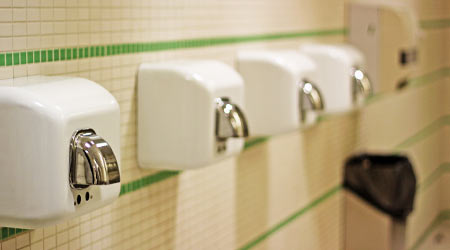
Hand dryers have come a long way since they were first introduced. In their early days, dryers were often categorized as noisy, awkward in appearance, costly and pretty ineffective. Today, models are quiet, sleek, environmentally friendly and far more successful at drying.
But, even as dryers evolve and improve, facility cleaning managers struggle with accepting their advantages. Questions regarding drying speed, hygiene, sustainability and overall benefits still plague decision makers.
In this piece, we asked managers to submit questions they have surrounding hand dryers. Those questions were then presented to product manufacturers. Here are their responses.  Sam Bernard
Sam Bernard
Global Category Director
Dyson Professional
 William Gagnon
William Gagnon
Vice President of
Marketing & Sales
Excel Dryer, Inc.
 Dan Storto
Dan Storto
President
World Dryer
What are the top three misconceptions of hand dryers?
Bernard: Not all hand dryers are created equal. Some can be frustratingly slow, causing users to give up and leave with their hands still damp, while others lack effective filtration of the air, potentially creating a hygiene problem. Reliability can also be an issue with some hand dryers. But the latest high-speed hand dryers can dry hands quickly and hygienically, while reducing maintenance, cost and environmental impact in the washroom. Well engineered hand dryers should last for many years, even in the highest traffic washrooms.
Gagnon: Number one would probably be the false notion that hand dryers are less hygienic than paper towels. The fact is, germ removal happens through proper handwashing, regardless of drying method. A study by The Mayo Clinic found “no statistically significant differences in the efficiency of 4 different hand-drying methods for removing bacteria from washed hands.” Further, a study by Laval University published in the American Journal of Infection Control suggests that paper towel use could actually deposit germs on hands, as its research revealed 17 species of bacteria on unused, recycled paper towels (the most common type being Bacillus, which causes foodbourne illness). For an extra measure of clean, we offer an air-purifying HEPA Filtration System as an optional feature of our high-efficiency hand dryers.
A second misconception relates to environmental concerns. Some believe that paper towels made from recycled material are a “greener” option than hand dryers. A Life Cycle Assessment (LCA) Study conducted by Quantis, an international life cycle assessment research firm, and peer reviewed to ISO 14040 Standards, disproved this notion for our original, patented, high-speed, energy-efficient hand dryer. The study determined that when compared to traditional electric hand dryers and paper towels (virgin and 100% recycled content), the high-efficiency dryer reduces the Climate Changing Score (carbon footprint) of hand drying by 50%-75%.
Another unfounded concern relates to cost. Converting from paper towels to our energy-efficient hand drying units actually represents a 95% cost savings. The dryer is a one-time purchase; once installed, it requires significantly less attention than paper towel dispensers, saving you money on labor and maintenance. Further, in contrast to paper towels, which can cost $15-$30 or more per case, the energy costs of using a hand dryer amount to pennies per day.
Storto: One of the main misconceptions is that because hand dryers use electricity, they are worse for the environment than paper towels. In fact, the opposite is true if you look at the environmental impact of producing paper towels and the waste they generate. Today's hand dryers are extremely energy efficient, using as little as 950 watts of power.
There has also been some discussion that hand dryers might blow more germs around the restroom than paper towels do, however, the research is inconclusive about whether either method of hand drying is better or worse in that regard. Many new hand dryer models incorporate antimicrobial technology and have HEPA filters to remove contaminants from the air while drying.
How To Choose Hand Dryers

 The Down and Dirty on Cleaning in Virus Season
The Down and Dirty on Cleaning in Virus Season How Surfactant Use is Expanding in Commercial Cleaning
How Surfactant Use is Expanding in Commercial Cleaning